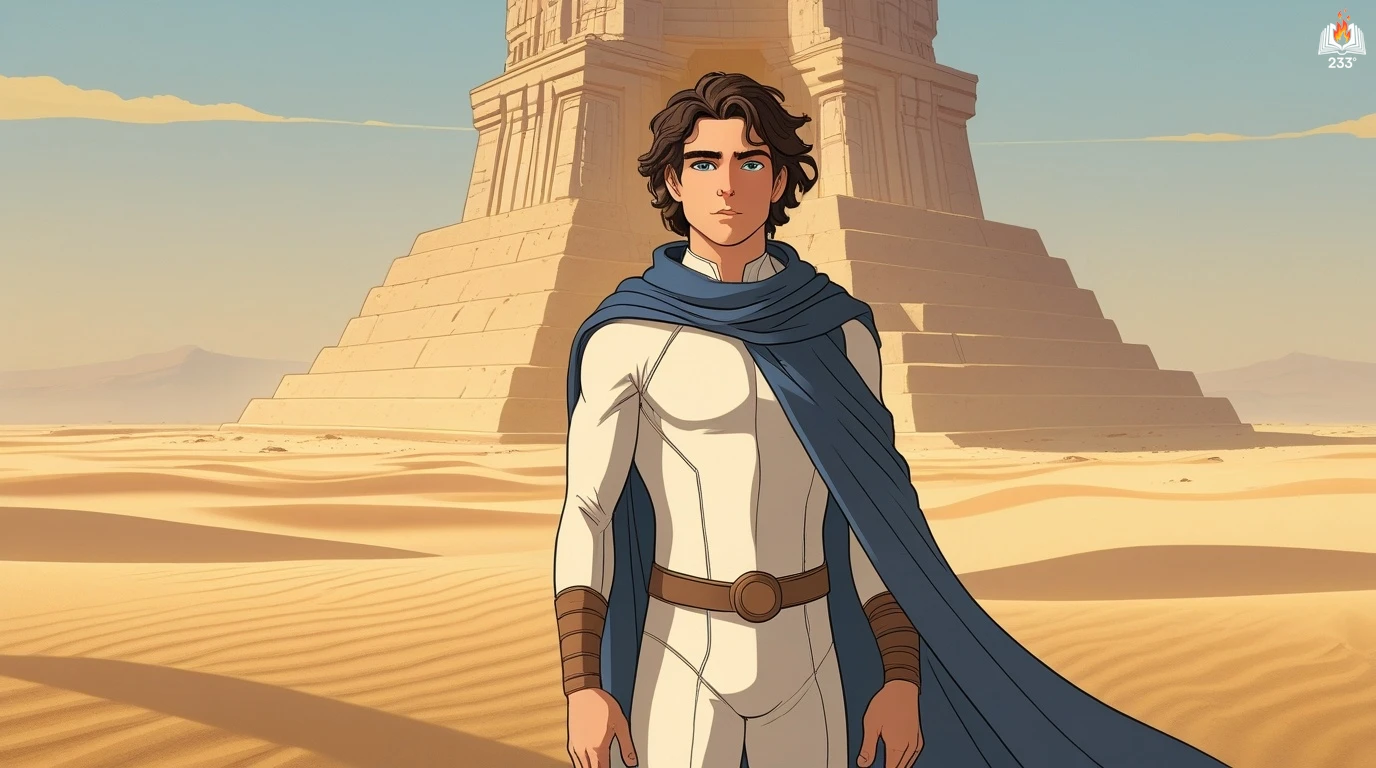Mentats of Dune, written by Brian Herbert and Kevin J. Anderson and published in March 2014, is part of the expansive Dune universe, continuing the Great Schools of Dune trilogy. The novel explores the turbulent rise of the Mentat School amid political intrigue, religious extremism, and the shadow of forbidden technology, enriching the lore set thousands of years before Frank Herbert’s classic Dune.
Plot Summary
The air over Lampadas hung thick with moisture, the smell of marsh and decay seeping into the foundations of the Mentat School. Gilbertus Albans, its master, moved quietly through the halls, masking his unnatural youth beneath gray powder and weathered robes. Long centuries had taught him survival, but the tides of the Imperium were shifting, and survival was no longer guaranteed. Fanaticism spread like wildfire across the galaxy, and the Butlerians, led by the impassioned Manford Torondo, threatened to rip apart the delicate balance between faith and reason.
Gilbertus stood at the heart of that fragile equilibrium. His school, dedicated to training human minds to reach computational heights once reserved for thinking machines, embodied the very conflict tearing through the Imperium. His most trusted students, like Draigo Roget, looked to him for wisdom, unaware of the ancient secret he carried – the hidden guidance of the machine-mind Erasmus, buried deep in Gilbertus’s past.
The arrival of Prince Roderick Corrino brought uneasy winds to the school. With him came Lady Orenna, and together they sought assurance that Anna Corrino, the Emperor’s damaged sister, was safe within Gilbertus’s care. Anna drifted between lucidity and confusion, her mind wounded by the failed Sisterhood trials on Rossak. She watched the marshlands, counting flies and grass, her voice a soft echo in the vast observatory. Gilbertus promised progress, yet feared discovery – the Butlerians hovered too close, their suspicion sharpened by the scent of rebellion.
Far across the stars, on Salusa Secundus, Emperor Salvador Corrino trembled under the pressures of his reign. Between the demands of the Butlerians and the manipulations of Josef Venport, ruler of VenHold, Salvador found himself pulled in opposite directions, his empire a glass vessel poised to crack. Venport, a master of commerce and technology, wielded the spice-fueled Navigators and a vast shipping empire, defying Butlerian decrees and enforcing an embargo against worlds that rejected progress. His wife, Cioba, stood at his side, her voice the cool temper to his sharp resolve. On the radiation-battered world of Baridge, Venport watched a Butlerian warship fall beneath his superior weapons, a calculated display meant to remind all of the price of defiance.
Manford Torondo, the Half-Man, twice the leader, rode atop Anari Idaho’s broad shoulders, a living icon of resistance. Where he moved, fire followed. Villages fell, leaders were executed, and the Butlerian movement swelled. In a small settlement called Dove’s Haven, three mayors faced Manford’s justice as Swordmasters raised their blades. Blood marked the earth, not as vengeance, Manford claimed, but as a lesson. By his side, Director Rolli Escon of EsconTran watched, pale and shaken, yet bound by profit and fear to the movement’s holy war.
The Sisterhood, shattered and exiled, found its flickering hope on Wallach IX. Reverend Mother Raquella Berto-Anirul, once the heart of Rossak, now rebuilt her order among the snow-laced peaks, aided by Venport’s quiet patronage. Among the new arrivals were Valya and Tula Harkonnen, sisters bound by grief and ambition. Valya, newly transformed by the brutal Agony, carried the weight of generations in her blood and the searing need for vengeance against the Atreides name. Tula, young and untested, followed in her sister’s shadow, destined to be shaped by the Sisterhood’s relentless demands.
On Arrakis, the desert world still whispered with the sound of sandworms beneath the dunes. Vorian Atreides, a figure of legend now seeking anonymity, walked among spice traders and harvesters, his name all but forgotten. He hid his agelessness beneath a simple identity, working alongside Captain Marius Phillips, negotiating bribes and trades in the unforgiving markets. Yet history never slumbered, and the ghosts of war, honor, and loss stirred in the desert winds, waiting for the moment to rise.
As the political storm raged, Gilbertus found himself walking a razor’s edge. The Mentat School became a pressure point, its existence a challenge to both fanatics and skeptics. Manford Torondo’s gaze turned toward Lampadas, suspicious of any place where minds sharpened without his blessing. Draigo Roget, loyal to Venport yet bound by affection to his old master, wrestled with his conscience, caught between rebellion and duty. Anna Corrino, fragile and drifting, became both a pawn and a symbol – her recovery, a triumph for human resilience, or her collapse, a monument to ambition’s cost.
Venport, in turn, escalated his war against the Butlerians, his ships moving with precision across the Imperium, cutting off planets, sowing both fear and dependence. His strategies were ruthlessly effective, but each victory deepened the divide, setting the stage for a reckoning the galaxy could no longer avoid.
Valya Harkonnen, on Wallach IX, prepared her sister for initiation into the Sisterhood’s new ranks, her mind sharpened by both the Sisterhood’s mission and the darker pulse of vengeance. The griffin emblem she bore on her cloak spoke not only of family pride but of a legacy drenched in betrayal and blood. She knew that the struggle for survival was no longer about survival alone – it was about reclaiming a place in a galaxy reshaped by war, faith, and the human hunger for power.
The currents of the Imperium surged toward confrontation. Gilbertus, caught in the gathering storm, worked feverishly to preserve his school, negotiating, compromising, and masking his true self behind layers of strategy. Yet even the most brilliant calculations could not account for the human heart’s unpredictability. Manford’s followers, emboldened by blood and sacrifice, grew bolder, their fires creeping ever closer. Venport tightened his grip, refusing to yield to superstition. Raquella, patient and wise, prepared her order for a future in which women’s cunning might prove the only anchor in a chaotic sea.
And in the deserts of Arrakis, Vorian Atreides continued his quiet exile, a man who had once shaped history now walking in its shadow, watching the sand shift and the spice blow, knowing that in the end, the past was never truly buried.
As dawn broke across Lampadas and the sun warmed the cold stones of Wallach IX, as ships streaked through the void and soldiers marched beneath banners of fire and faith, the Imperium teetered between enlightenment and annihilation. The Mentats, the Butlerians, the Sisterhood, the Navigators, and the scattered bloodlines of houses old and new – all moved toward a fate none could fully see, save perhaps the man behind the mask of mortality, Gilbertus Albans, and the machine mind whispering in his ear.
Main Characters
Gilbertus Albans: The cautious and brilliant headmaster of the Mentat School, Gilbertus is a man of contradictions, secretly mentored by the robot Erasmus while outwardly navigating a world hostile to machines. His internal struggle between survival and his hidden past shapes his leadership and the destiny of the school.
Raquella Berto-Anirul: The aging Mother Superior of the Sisterhood, Raquella leads the rebuilding of the Bene Gesserit order on Wallach IX after its near-destruction. Her resilience and visionary belief in shaping human genetics drive her to forge alliances and navigate treacherous political waters.
Draigo Roget: A gifted former student of Gilbertus and now an independent Mentat allied with Josef Venport, Draigo balances loyalty to his mentor with the need to stand against the growing Butlerian threat. His conflict mirrors the ideological battles of the era.
Josef Venport: The ruthless Directeur of VenHold, Venport embodies technological ambition. Determined to crush the Butlerians and secure his commercial empire, he manipulates events across the galaxy, seeing the Mentats as a crucial piece in his strategy.
Manford Torondo: The charismatic and fanatical leader of the Butlerian movement, Manford seeks to purge humanity of its dependence on technology. His blend of populist fervor and authoritarian control fuels much of the novel’s tension.
Anna Corrino: A tragic figure damaged by a failed Sisterhood ritual, Anna is sheltered at the Mentat School. Her fragile state makes her both a pawn in the political game and a symbol of the era’s brutal human experiments.
Valya Harkonnen: A determined Reverend Mother who survived the Agony, Valya aims to reclaim her family’s honor and elevate the Sisterhood’s influence. Her transformation represents both personal ambition and the larger arc of human evolution.
Theme
Human Potential vs. Machine Dependence: The novel examines humanity’s struggle to surpass its limits without relying on forbidden technology. Mentats, human computers trained in logic and analysis, embody this tension, representing both triumph and danger in a post-machine world.
Fanaticism and Control: Through the Butlerian movement, the story delves into the dangers of religious extremism and mass manipulation. Manford’s crusade against technology threatens to unravel civilization, exposing the thin line between faith and tyranny.
Power and Legacy: Characters grapple with the legacies they hope to leave behind – Gilbertus with his school, Raquella with the Sisterhood, and Venport with his empire. The novel suggests that true legacy requires sacrifice and often comes at great personal cost.
Survival and Adaptation: In a universe reshaped by war and technological collapse, survival hinges on adaptability. Whether it’s the Sisterhood rebuilding, the Mentats navigating political traps, or Venport’s expansionist tactics, the characters constantly adjust to survive.
Writing Style and Tone
Brian Herbert and Kevin J. Anderson’s writing style in Mentats of Dune is detailed, multi-threaded, and rich with political machinations. They employ a rotating third-person perspective that moves between key players, allowing readers to experience the sweeping galactic drama from multiple angles. Their prose balances introspection with action, often using internal monologues and philosophical musings to deepen character motivations. The authors build tension through a combination of intricate plotting and moral ambiguity, keeping readers engaged as alliances shift and stakes rise.
The tone is thoughtful and often somber, reflecting the weight of history and the high stakes of the characters’ choices. There’s a persistent undercurrent of unease, driven by the rise of fanaticism and the fragility of progress. Yet moments of hope, resilience, and even tenderness emerge, especially in the relationships between mentors and students or between allies struggling for a better future. This tonal complexity enriches the novel’s exploration of ambition, fear, and the price of enlightenment.
We hope this summary has sparked your interest and would appreciate you following Celsius 233 on social media:
There’s a treasure trove of other fascinating book summaries waiting for you. Check out our collection of stories that inspire, thrill, and provoke thought, just like this one by checking out the Book Shelf or the Library
Remember, while our summaries capture the essence, they can never replace the full experience of reading the book. If this summary intrigued you, consider diving into the complete story – buy the book and immerse yourself in the author’s original work.
If you want to request a book summary, click here.
When Saurabh is not working/watching football/reading books/traveling, you can reach him via Twitter/X, LinkedIn, or Threads
Restart reading!








